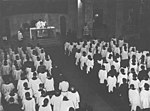Holy Rosary–Danish Church Historic District

Holy Rosary–Danish Church Historic District, also known as Fletcher Place II, is a national historic district located at Indianapolis, Indiana. The district encompasses 183 contributing buildings in a predominantly residential section located in the central business district of Indianapolis. It was developed between about 1875 and 1930, and include representative examples of Italianate, Gothic Revival, Tudor Revival, and Renaissance Revival style architecture. Located in the district is the separately listed Horace Mann Public School No. 13. Other notable buildings include the John Kring House (c. 1872), Trinity Danish Evangelical Lutheran Church (1872), John Wands House (1857), Henry Homburg House (c. 1870), Samuel Keely House (c. 1870), Maria Wuensch Cottage (c. 1900), and Holy Rosary Catholic Church (1911-1925).It was listed on the National Register of Historic Places in 1986.
Excerpt from the Wikipedia article Holy Rosary–Danish Church Historic District (License: CC BY-SA 3.0, Authors, Images).Holy Rosary–Danish Church Historic District
East McCarty Street, Indianapolis
Geographical coordinates (GPS) Address Nearby Places Show on map
Geographical coordinates (GPS)
| Latitude | Longitude |
|---|---|
| N 39.756388888889 ° | E -86.147222222222 ° |
Address
East McCarty Street 636
46203 Indianapolis
Indiana, United States
Open on Google Maps









